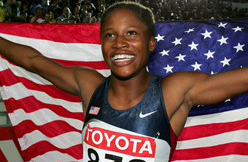Lauryn Williams' transition from Olympic track and field star to bobsled hopeful has been humbling and successful, not to mention a bit terrifying.
As fast as Williams was on land, it's a different experience rocketing down an icy track in a 400-pound sled at speeds up to 90 mph.
“I knew so little (the first time down the track), and I ran and jumped in, and it was just a combination of swearing and praying the whole way down,” said Williams, a former Rochester High star who won WPIAL and PIAA track titles. “I thought, ‘I don't know what I got myself into,' and I was 50-50 whether I was going to come back the next day.”
Elite athletes such as Williams aren't known for backing down from challenges, however, and she returned the next day. Williams, who announced her retirement from track competition in June, finished third in the 2013 Women's Bobsled Push Championships in Calgary in July. She, fellow Olympic track star Lolo Jones and seven other women were named to Team USA at the end of October and are in the midst of the competition season that will play a large part in determining who goes to the Winter Olympics in Sochi, Russia, in February.
No female U.S. track and field Olympic athlete has competed in the Winter Games. The team will be announced Jan. 19.
Jazmine Fenlator, who drove the sled with Jones as the pusher in last year's World Cup circuit, ran track at Rider, and her coach not only suggested she consider bobsled but also submitted an athletic resume on her behalf.
“I thought it was a joke at first, watching “Cool Runnings” growing up, and I'm half Jamaican so I was like, ‘Come on, Coach, this isn't funny,' ” she said. “But I always grew up knowing that if a door opens, you never know what's on the other side. Take a risk because it could lead you down another path.”
Fenlator said the training for bobsled is similar to track and field.
“Our sled is 400 pounds, and you have to accelerate and propel that, and that's what you do as a track and field athlete,” she said. “You're propelling your body weight as fast as possible, whether you're long jumping, throwing an implement or running the 100 meters.”
Learning the bobsled equipment and nuances of the sport is the challenging part, Fenlator said. There are only a certain number of tracks in the world, athletes have only a limited amount of time to spend on those tracks, and they also serve as their own mechanics and caddies. Growing comfortable with the speed and gravitational forces adds another layer to the process.
Williams, who was recruited by Jones, said it was humbling to be a “fish out of water,” taking direction from others and becoming a student again after so many years of competing as an elite athlete on the track.
“I saw the run and jump-in part (of bobsled) and thought that was the extent of it, but a lot goes on behind the scenes,” Williams said.
Williams is aware that competing in the Summer and Winter Olympics would land her in rare company, but that isn't why she's doing it.
“I didn't get into this to be famous or be one of the few black female bobsledders or first to compete in the winter and summer,” she said. “That's all really cool, but I'm here more for the adventure and the fun, to add another story to my life.”

(triblive.com)



